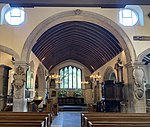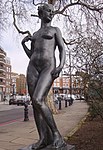Couper Collection
Art collections in the United KingdomArt museums and galleries in LondonDefunct museums in LondonMuseums in the London Borough of WandsworthUnited Kingdom art museum and gallery stubs ... and 1 more
Use British English from August 2015

The Couper Collection was a registered charity, which for many years exhibited its art in a floating gallery on converted barges, moored on the banks of the Thames in Battersea, London. It exhibited artworks and installations by artist Max Couper, as well as hosting exhibitions and events by other artists. The Collection began in 1979 as a base for a large sculpture in Battersea Park. In 1999 it was launched as a charity by then UK Home Secretary Jack Straw MP. The Collection no longer exists.
Excerpt from the Wikipedia article Couper Collection (License: CC BY-SA 3.0, Authors, Images).Couper Collection
Albion Riverside, London Battersea (London Borough of Wandsworth)
Geographical coordinates (GPS) Address Nearby Places Show on map
Geographical coordinates (GPS)
| Latitude | Longitude |
|---|---|
| N 51.480833333333 ° | E -0.16916666666667 ° |
Address
Foster+ Partners
Albion Riverside
SW11 3BG London, Battersea (London Borough of Wandsworth)
England, United Kingdom
Open on Google Maps











